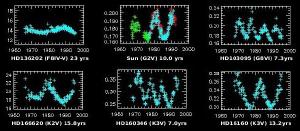Post
Cycle of Stars
9 April 2013
 Mount Wilson Observatory
Mount Wilson ObservatoryWe generally think of the Sun as a steady constant, but it’s actually quite variable. The Sun’s magnetic field varies over time, which means the activity of the Sun varies. The earliest observation of this cycle was seen in sunspots. While sunspots were observed throughout history, in the early 1600s astronomers began making regular observations of sunspots, and soon discovered an 11-year cycle of high and low sunspot activity. Over time similar variations in solar flare activity and brightness. Thus the Sun cycles through active and quiet periods.
In the early 1800s Joseph von Fraunhofer discovered that sunlight was not a continuous range of colors, but rather had gaps at certain wavelengths. These gaps are now called Fraunhofer lines, and we now know they are cause by the Sun’s atmosphere absorbing certain wavelengths of light the Sun produces. The specific wavelengths that are absorbed depends on the type of atoms and molecules which are in the Sun’s atmosphere. We see the same effect in the light of other stars, which is how we can determine the types of elements a particular star has.
Two of these absorption lines in the ultraviolet are known as the H and K lines. They are due to the presence of calcium in the Sun’s atmosphere. These particular lines are affected by magnetic activity, so when the Sun is active you can actually get H and K emission lines. The greater the magnetic activity, the stronger these lines are. This is useful because we can observe these spectral lines in other stars.
Directly measuring the magnetic activity of other stars is very difficult, since we can’t observe most stars as a disk. That means we can’t observe sunspots on stars other than our Sun (starspots). But since we can observe the H and K lines of stars, and these correlate to magnetic activity, we can observe these lines over time to study the activity cycles of other stars.
In 1966, Mount Wilson Observatory began a project to observe the H-K lines of about a hundred local stars. The project has been ongoing continuously, and now monitors about 400 stars. This means we have long-term observations of the activity cycles of hundreds of stars. You can see examples of these in the figure above. Some stars have short activity cycles (less than 3 years), while others have cycles of more than 20 years. A few stars seem to be in a long inactive period, similar to the Maunder minimum our Sun had in the late 1600s.
We now have other ways to observe stellar activity cycles. For example, the Sun’s active periods also produce more x-rays. X-ray telescopes such as XMM-Newton have observed similar variations in sun-like stars, and these cycles correlate to the H-K cycles of the stars.
Observations such as these continue to confirm that our Sun is just a star like many others throughout the galaxies. There are billions of stars in the universe, but we think one of them is special, simply because it’s ours.